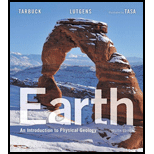
The match for each of the processes of a, b and c with the given zones depending upon the dominant processes operating in the different parts of a river system.
Answer to Problem 1GST
The dominant processes that match with the zones are as follows:
Zone #1: a. sediment production.
Zone #2: c. sediment transportation.
Zone #3: b. sediment deposition.
Explanation of Solution
Streams are channels of water that flow on the surface of the earth. Streams flow in different networks and finally join the surface water in the sea.
Zone #1: a. sediment production. This is a zone in which most of the sediments are originated or developed mainly due to erosion and by mass wasting, and overland flow. This zone is mainly located in the headwater region of a river system.
Zone #2: c. sediment transportation. Here, the sediments from the production zone are transported through the drainage network in a balanced state of erosion and accumulated along the banks of stream channels.
Zone #3: b. sediment deposition. This is a zone in which the river reaches the ocean or a large body of water such as lake. The energy of transported sediments will reduce and accumulated as deltas and different coastal features and the further movement of sediments led to deposition on the ocean basins.
Want to see more full solutions like this?
Chapter 16 Solutions
Earth: An Introduction to Physical Geology (12th Edition)
- Evaporation Evaporation 320,000 km³ Oceans Hydrologic Cycle Precipitation Precipitation 96,000 km³ Precipitation 284,000 km³ Evaporation/Transpiration 60,000 km³ Runoff 36,000 km³ Runoff Infiltrationarrow_forward1. Globally, from which source does more water evaporate into the atmosphere: oceans or land? 2. Approximately what percentage of the total water evaporated into the atmosphere comes from the oceans?Percentage from oceans = Ocean evaporation/Total evaporation × 100% = _____ % 3. Notice in Figure 8.1 that more water evaporates from the oceans than is returned directly by precipitation. If sea level is not dropping, identify a source of water for the oceans in addition to precipitation. 4. Worldwide, about how much of the precipitation that falls on the land becomes runoff: 35, 55, or 75 percent? 5. Much of the water that falls on land does not immediately return to the ocean via runoff. Instead, it is temporarily stored in reservoirs such as lakes. In some mountainous and polar regions, what features serve as reservoirs to temporarily store water?arrow_forwardEnergy conservation is one way to decrease dependence on fossil fuels. What are some things that can be done at home, work, or school that would reduce fossil-fuel use and save money?arrow_forward
- Since the 1970s, the median age of people in North America has done what? Increased Decreased Stayed about the same Decreased dramaticallyarrow_forwardNorth America has experienced a demographic transition that resulted in what kind of changes in the population of North America? Lower birthrates, lower death rates, and longer life expectancies Higher birthrates, lower death rates, and longer life expectancies Lower birthrates, higher death rates, and shorter life expectancies Higher birthrates, higher death rates, and shorter life expectanciesarrow_forwardAccording to the views of animal rights activists opposed to animal experimentation which of the following statements applies? Animal experimentation should be permitted only when medical progress cannot be achieved in any other way. Animal experimentation should be permitted only when the animals involved come from a shelter where they were destined to be killed. Animals have the same rights and moral status that human beings do. We should not apply Kant's Practical Imperative to animals.arrow_forward
- 72 ic 18 The planets 1 Can you find eleven Solar System words in the grid? e E W b V e n a e P r r + h C i - PU 0 0 n c e t S c e r P W n P i t e r U 6 r f U n - K σ г m a r S n W e t Y g n d r e E C Y O P U S t a r > S a t U r n 2 Rearrange the letters into the names of the planets. a ucerr My c un Ves e hrtEa g sarM b ruepitj d rntSau f uneNtep_ h nasu Urarrow_forwardAnswer the photoarrow_forwardwhat are your thoughts on the critical importance of soil management and its impact on agricultural productivity and environmental health, and role of conservation tillage. write in first personarrow_forward
- Five arguments that the Water Bottle Bill was passed as a means of "revenue" enhancement In developing your arguments you should start at the website of the Connecticut State Library which contains the history of all legislation passed by the Connecticut Legislature http://ctstatelibrary.org/leghistory_ to gather the information for your arguments. use referencesarrow_forwardDescribe the importance of recycling household solid wastesarrow_forwardWhy is food waste a growing concern? Describe how some communities are addressing the food waste issue.arrow_forward
 Applications and Investigations in Earth Science ...Earth ScienceISBN:9780134746241Author:Edward J. Tarbuck, Frederick K. Lutgens, Dennis G. TasaPublisher:PEARSON
Applications and Investigations in Earth Science ...Earth ScienceISBN:9780134746241Author:Edward J. Tarbuck, Frederick K. Lutgens, Dennis G. TasaPublisher:PEARSON Exercises for Weather & Climate (9th Edition)Earth ScienceISBN:9780134041360Author:Greg CarbonePublisher:PEARSON
Exercises for Weather & Climate (9th Edition)Earth ScienceISBN:9780134041360Author:Greg CarbonePublisher:PEARSON Environmental ScienceEarth ScienceISBN:9781260153125Author:William P Cunningham Prof., Mary Ann Cunningham ProfessorPublisher:McGraw-Hill Education
Environmental ScienceEarth ScienceISBN:9781260153125Author:William P Cunningham Prof., Mary Ann Cunningham ProfessorPublisher:McGraw-Hill Education Earth Science (15th Edition)Earth ScienceISBN:9780134543536Author:Edward J. Tarbuck, Frederick K. Lutgens, Dennis G. TasaPublisher:PEARSON
Earth Science (15th Edition)Earth ScienceISBN:9780134543536Author:Edward J. Tarbuck, Frederick K. Lutgens, Dennis G. TasaPublisher:PEARSON Environmental Science (MindTap Course List)Earth ScienceISBN:9781337569613Author:G. Tyler Miller, Scott SpoolmanPublisher:Cengage Learning
Environmental Science (MindTap Course List)Earth ScienceISBN:9781337569613Author:G. Tyler Miller, Scott SpoolmanPublisher:Cengage Learning Physical GeologyEarth ScienceISBN:9781259916823Author:Plummer, Charles C., CARLSON, Diane H., Hammersley, LisaPublisher:Mcgraw-hill Education,
Physical GeologyEarth ScienceISBN:9781259916823Author:Plummer, Charles C., CARLSON, Diane H., Hammersley, LisaPublisher:Mcgraw-hill Education,





